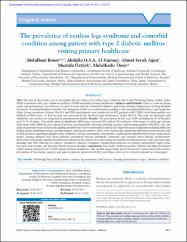| dc.contributor.author | Bener, Abdulbari | |
| dc.contributor.author | Al‑Hamaq, Abdulla O. A. A. | |
| dc.contributor.author | Ağan, Ahmet Faruk | |
| dc.contributor.author | Öztürk, Mustafa | |
| dc.contributor.author | Ömer, Abdulkadir | |
| dc.date.accessioned | 2020-03-24T06:45:42Z | |
| dc.date.available | 2020-03-24T06:45:42Z | |
| dc.date.issued | 2019 | en_US |
| dc.identifier.citation | Bener, A., Al-Hamaq, A. O. A. A., Ağan, A. F., Öztürk, M. ve Ömer, A. (2019). The prevalence of restless legs syndrome and comorbid condition among patient with type 2 diabetic mellitus visiting primary healthcare. Journal of Family Medicine and Primary Care, 8(12), 3814-3820. http://doi.org/10.4103/jfmpc.jfmpc_463_19 | en_US |
| dc.identifier.uri | http://doi.org/10.4103/jfmpc.jfmpc_463_19 | |
| dc.identifier.uri | https://hdl.handle.net/20.500.12511/5083 | |
| dc.description.abstract | AIM: The aim of this study was to determine the prevalence of restless legs syndrome (RLS) and Pittsburgh Sleep Quality Index (PSQI) in patients with type 2 diabetes mellitus (T2DM) attending primary healthcare. SUBJECTS AND METHODS: This is a cross-sectional study and participants were between 25 and 70 years old who visited the diabetes and endocrinology department of Mega Medipol University Teaching Hospital, Istanbul. The diagnosis of RLS was performed according to the International Restless Legs Syndrome Study Group consensus criteria. The RLS and PSQI instruments were conducted on 871 patients with T2DM. Good sleep quality was defined as PSQI score <5. RLS severity was assessed by the Restless Legs Syndrome-6 Scales (RLS-6). The scale development and validation was carried out using Rasch measurement model. RESULTS: The prevalence of RLS was 22.8% including 60.3% of females and 39.7% of males. This study showed significant differences between RLS and no RLS patients with respect to their age (years), body mass index (BMI) (kg/m2), physical activity, smoking habit, sheesha smoking, income, and sleeping quality with PSQI. Also, the analysis presented that statistically significant differences between both RLS and no RLS reported sleep complaints including difficulty falling asleep, inadequate sleep, anytime fatigue, and leg discomfort. There were statistically significant differences between RLS and no RLS patients regarding hypoglycemia, numbness in legs, retinopathy, neuropathy, nephropathy high blood pressure, depression, stroke, anemia, diabetic foot, ulcer, arthritis, respiratory disease, metabolic syndrome, and coronary heart disease. Furthermore, there were statistically significant differences between RLS and no RLS concerning the number of sleeping hours, wake-up time (AM), sleeping time (PM), BMI (kg/m2), HbA1c, vitamin D, calcium, creatinine, fasting blood glucose, low-density lipoprotein, triglyceride, uric acid, and systolic and diastolic blood pressure (mmHg). CONCLUSION: This study confirms positive relation and high prevalence of RLS among patients with T2DM visiting primary healthcare. The results suggest that physical activity is associated with a better perception of functional capacity and pain in diabetic patients with RLS, and thus a more active lifestyle should be encouraged. | en_US |
| dc.language.iso | eng | en_US |
| dc.rights | info:eu-repo/semantics/openAccess | en_US |
| dc.rights | Attribution-NonCommercial-ShareAlike 4.0 International | * |
| dc.rights.uri | https://creativecommons.org/licenses/by-nc-sa/4.0/ | * |
| dc.subject | Pittsburgh Sleep Quality Index | en_US |
| dc.subject | Restless Leg Syndrome | en_US |
| dc.subject | Risk Factors | en_US |
| dc.subject | Sleeping Disturbances | en_US |
| dc.subject | Type 2 Diabetes Mellitus | en_US |
| dc.title | The prevalence of restless legs syndrome and comorbid condition among patient with type 2 diabetic mellitus visiting primary healthcare | en_US |
| dc.type | article | en_US |
| dc.relation.ispartof | Journal of Family Medicine and Primary Care | en_US |
| dc.department | İstanbul Medipol Üniversitesi, Uluslararası Tıp Fakültesi, Dahili Tıp Bilimleri Bölümü, İç Hastalıkları Ana Bilim Dalı | en_US |
| dc.authorid | 0000-0002-7902-5803 | en_US |
| dc.authorid | 0000-0003-2209-7694 | en_US |
| dc.identifier.volume | 8 | en_US |
| dc.identifier.issue | 12 | en_US |
| dc.identifier.startpage | 3814 | en_US |
| dc.identifier.endpage | 3820 | en_US |
| dc.relation.publicationcategory | Makale - Uluslararası Hakemli Dergi - Kurum Öğretim Elemanı | en_US |
| dc.identifier.doi | 10.4103/jfmpc.jfmpc_463_19 | en_US |



















